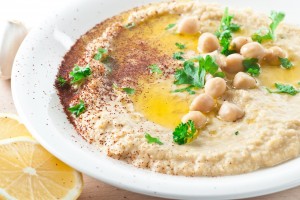 Hummus is a traditional Middle Eastern spread that has quickly been gaining popularity in Western culture. It’s typically made with pureed chickpeas (garbanzo beans), lemon juice or vinegar, olive oil, garlic, and tahini (a paste made from sesame seeds).
Hummus is a traditional Middle Eastern spread that has quickly been gaining popularity in Western culture. It’s typically made with pureed chickpeas (garbanzo beans), lemon juice or vinegar, olive oil, garlic, and tahini (a paste made from sesame seeds).
Ingredients & Nutrition Info
The main component of hummus (chickpeas) is high in fiber and protein, and contains vitamins and minerals like folic acid, zinc, magnesium, manganese, iron, and copper. In fact, chickpeas are higher in folic acid than many of their other bean counterparts! Additionally, the tahini in hummus also contributes to the elevated fiber content in hummus. In fact, the high fiber content in hummus is what lends it to having such a variety of health benefits:
- Reduces risk of constipation.
- Promotes a healthy digestive tract.
- Helps regulate blood sugar, which is particularly helpful for diabetics.
- Keeps cholesterol levels low.
- Promotes better heart health.
Plus, the high fiber and high protein content make hummus a health conscious individual’s top choice, as it can provide a satisfying, filling snack for minimal calories.
Favorite Food & Snack Ideas With Hummus
- Hummus with raw vegetables (i.e. carrots, snow peas, cucumber slices, cherry tomatoes, & broccoli).
- Half a whole wheat pita that has been sliced and toasted in the oven, used to dip into hummus.
- As a spicy spread, combined with salsa and scooped up with whole grain crackers.
- As a mayonnaise substitute on sandwiches.
- In tuna salad or chicken salad, mixed with tuna or chicken, diced celery, diced carrots, hummus, and black pepper.
- Thinned with extra lemon juice or apple cider vinegar for a zesty, homemade salad dressing.
- “Hummus pizza” (top a whole grain tortilla or pita with hummus, sliced tomatoes, and basil then toast under a broiler for a couple minutes).
- Grilled hummus & tomato sandwich, on whole grain bread.
There are many brands manufacturing hummus, so when looking for a container to bring home with you the most important thing to consider is the use of excess fat, salt, and any other additives. The only fat you should see in the ingredients should be olive oil, and if salt is listed, it should be the last ingredient listed. If there are any ingredients that you can not pronounce, leave it on the grocery store shelf! Or, to be safe, you could make your own hummus at home (which should last you up to a week when stored in the refrigerator). For a low-fat, low-sodium hummus, try the recipe below:
Recipe: Low-Fat, Low-Sodium Hummus
- 1 can chickpeas, rinsed and drained (try to find No Salt Added canned beans if you’re using canned. If you can’t find No Salt Added, rinsing the beans will remove up to 40% of the excess sodium.)
- 2 cloves garlic, chopped
- 3 tablespoons water or low-sodium vegetable broth
- 2 tablespoons fresh lemon juice
- 1 teaspoon tahini
- Freshly ground black pepper, if desired
Blend all the ingredients in a food processor until smooth. For other flavors, try blending in roasted red peppers (make sure if you buy canned that they are not packed in oil), spinach, fresh herbs, tomatoes, or jalapenos.
